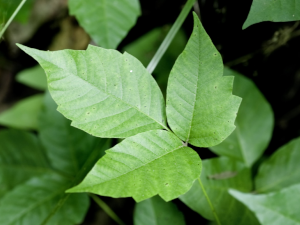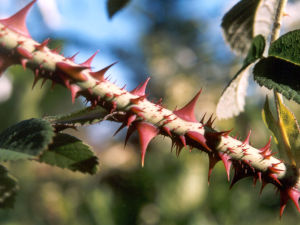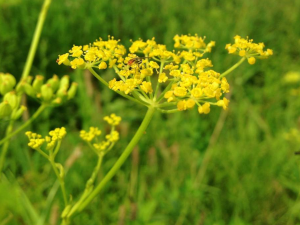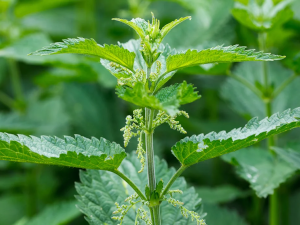Pesky Plants
Most plants strive to make the world a better place, bringing joy to our senses with their colorful display of flowers, their sweet aromas, and their delicious sugary fruit. Others are just jerks, hellbent of making the life of the innocent restoration volunteer a misery. On this page, we will single out those cowardly plants, learn how to identify them, and hopefully thwart their efforts.

Poison Ivy
This trailing and climbing vine is common throughout Kane County, often found along woodland borders and disturbed locations such as old fields. When touched it can cause a skin rash, your body’s reaction to the oil urushiol present on the leaves, stems, roots and fruit. Even if your clothing accidentally brushes up against the plant, you can still transfer the oil to your hands when removing these items.
Every volunteer should learn to recognize the leaves and stems in order avoid accidently contact. Each leaf of poison ivy is trifoliate - divided into three distinct leaflets - and the leaf stalks are arranged alternately along the stem. The two side leaflets have short stalks, and are asymmetrical with a notch on the bottom edge. The terminal leaflet has a much longer stalk, and is more or less symmetrical. This is the reason for the old saying of “Leaves of three, let it be”.
There is one plant that could easily be mistaken for poison ivy, and that is a small box-elder sapling. It too has leaves of three, but unlike the vine, its leaves and branches are oppositely arranged.
Poison ivy clings to trees with the aid of aerial roots that penetrate into the nooks and crannies of the bark. These roots are plentiful, and give the climbing vine a rather hairy appearance. In winter, the toxic vine can easily be easily mistaken for another native vine, Virginia Creeper. This plant also climbs with the aid of aerial roots, but rather than penetrating into crevices, they attach to surfaces with suction cups. In summer, distinguishing the two plants is much easier since Virginia creeper has leaves consisting of five leaflets arranged like the fingers of your hand.
If exposed to poison ivy, the recommended treatment is to immediately rinse the area with soap and water before the oil is absorbed into the skin. Unfortunately, this isn’t always an option during a workday, so check in with the steward to see if they have some poison ivy cream available.
Should you walk through an area with lots of poison ivy, it is advisable to clean your contaminated clothing in a wash cycle all by themselves.

Thorns, Spines and Prickles
Plants have evolved many ways to avoid being eaten, but the one that targets mammalian herbivores in particular are the presence of sharp pointy stabby things - namely, thorns, spines and prickles. While we are less worried about volunteers snacking on an twig of prickly ash, the same can not be said for walking through a patch of it. Likewise, the arching canes of blackberries and roses have been known to snare the unsuspecting volunteer.
Many of the plants we actively control during a workday are armed - buckthorn, callery pear, autumn olive, Japanese barberry, black locust, multiflora rose, and teasel. Being able to safely handle these plants requires you to be dressed appropriately and to have leather gloves.
When going head-to-head with multiflora rose, denim and cotton duct are your friends, but even then, the occasional expletive can be heard echoing through the woods. I have a dedicated pair of cotton duct jeans that I only wear on workdays - they take a beating, and I fully torn at some point.

Wild Parnsip
This is one plant you don’t want to mess around with. As a member of the carrot family, it shares in the characteristics common to the group: a hollow stem, a tap root, and of course, an inflorescence called an umbel. There is however another feature that many members of the carrot family possess: their toxicity.
The sap of wild parsnip is phytotoxic, containing a class of chemicals called furanocoumarins that make the skin hypersensitive to ultra-violet radiation. Simply put, get the sap on you during the day, its going to burn then blister within the next 24 to 48 hours. These burns even have a fancy name - phytophotodermatitis. Just like a bad sunburn, the skin will eventually heal itself within days, although discoloration can last months.
Wild parsnip is a biennial that can be can reach a height of 5 feet, with an umbel of yellow flowers that bloom from June to mid summer. The leaves are alternate, and compound with around nine leaflets. Here in Kane County, most other members of the carrot family have flowers that are white, the exception being golden alexanders. This native plant is smaller (2 ft), has compound leaves with 3 to 5 leaflets, and is going to be found in a prairie restoration, and not by the side of a road.

Nettles
There are two species of nettle in our region that can sting - the native wood nettle (Laportea canadensis), and aptly named stinging nettle (Urtica dioica) brought over from Europe. Both these plants are covered with tiny hollow hairs (trichomes) that have been stiffened by calcium carbonate and end in a silica tip. When a hapless volunteer brushes up against a nettle, the silica tip breaks, and the hair takes on the new role of a surgical needle, piercing the skin and injecting a fun mixture of chemicals.
Formic acid was originally thought to be the main culprit for the pain and inflammation, but the finger now points to a trio of neurotransmitters: histamine, serotonin, and acetylcholine.
There are many folk remedies to alleviate the sting of nettle - dock leaves are what I knew as a kid - but antihistamine is probably the best treatment against histamine. Go figure.
Familiarizing yourself with the appearance of nettle is key to avoidance. The most distinctive characteristic are the flowers, which are greenish in color, and develop from the axils of the leaves in branching clusters. Those of stinging nettle tend to more droopy.

 Volunteering
Volunteering Safety
Safety Wildlife
Wildlife Newsletter
Newsletter